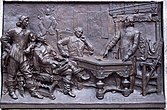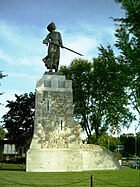Louis-Philippe Hébert
Louis-Philippe Hébert | |
|---|---|
 Louis-Philippe Hébert | |
| Born | 27 Jan 1850 Ste-Sophie de Mégantic, Quebec |
| Died | 13 June 1917 |
| Nationality | Canadian |
| Education | Napoléon Bourassa |
| Known for | sculptor, educator |
Louis-Philippe Hébert CMG (1850–1917) was the son of Théophile Hébert, a farmer, and Julie Bourgeois of Ste-Sophie de Mégantic, Quebec. Hébert was a sculptor who sculpted forty monuments, busts, medals and statues in wood, bronze and terra-cotta. He taught at the Conseil des arts et manufactures in Montreal, Quebec. He married Maria Roy on 26 May 1879 in Montreal, Quebec. The couple's eight children include Henri Hébert, a sculptor, and Adrien Hébert, a painter.
Hébert was a member of the Royal Canadian Academy of Arts (1880).[1] He was awarded the Medal of Confederation (1894). He was made a chevalier of France's Legion of Honour (1901). He was a Companion of St Michael and St George (Great Britain, 1903). The Prix Philippe-Hébert, named in his honour, has been given to an artist of outstanding ability and stature in Québec arts by the St-Jean-Baptiste Society of Montréal since 1971. He was buried in Notre-Dame-des-Neiges cemetery, Montreal, Quebec.
Works
Parliament Hill, Ottawa
-
Sir John A. Macdonald (1880s)
-
Queen Victoria (1900), dedicated by Prince George, Duke of Cornwall and York in 1901.
-
Alexander Mackenzie (1901).
Nova Scotia
-
Evangeline (unveiled 1920), Grand Pre, Nova Scotia
-
Libel trial of Joseph Howe, Supreme Court (current Legislative Library), Province House (Nova Scotia)
Quebec Parliament Building
-
« La Halte dans la forêt » Amerindian family sculpture facade of the Quebec Parliament Building, Québec City.
-
« La Halte dans la forêt » Amerindian family
-
Francis de Gaston, Chevalier de Levis sculpture
Montreal, Quebec
-
Edward VII Monument (Montreal) (1914) in Phillips Square
-
Jeanne Mance Monument at l'hôtel-Dieu de l'avenue des Pins
-
Jeanne Mance Monument at l'hôtel-Dieu de l'avenue des Pins
-
Bishop of Montreal, Ignace Bourget Monument (1903) is in front of Mary, Queen of the World Cathedral
-
Louis-Philippe Hébert's John Young (1908) was erected at the Old Port of Montreal.
-
John Young (1908) was erected at the Old Port of Montreal
Maisonneuve Monument
-
Maisonneuve Monument (1895) was erected in memory of Paul Chomedey de Maisonneuve in the Place d'Armes square Montreal, Quebec.
-
Mascaron.
-
Acte de foundation de Ville-Marie.
-
Mort heroique de Dollard au Long Sault.
-
Premiere messe a Ville-Marie.
Other
-
Bishop Joseph Eugene Guiges outside Notre-Dame Cathedral Basilica, Ottawa
-
Octave Crémazie Monument near the house of Émile Nelligan
-
Madeleine de Verchères (1927) was erected in Verchères, Quebec
-
Boer War monument in Central Memorial Park. Calgary, Alberta
- Monseigneur Bourget in Montreal, Quebec.
- Monseigneur de Laval in Quebec, Quebec.
- completed thirty large wooden sculptures in the choir of the Notre-Dame Cathedral Basilica, Ottawa including the Holy Family, John the Baptist and Patrick, the patron saints of English and French Catholics.
- monument at Parliament Hill (Quebec City) to soldiers Short and Wallick (1891), two heroes who saved the inhabitants of the fire at Saint-Sauveur in the lower town of Quebec in 1889)
- monument of Father André Garin, priest at St.-Jean-Baptiste Church, at Lowell, Massachusetts.
References
- Bruno Hébert 'Louis-Philippe Hébert (1850–1917)' 1890
- <https://web.archive.org/web/20100613213017/http://ecommunity.uml.edu/francolowellma/history/memorial.htm>
- ^ "Members since 1880". Royal Canadian Academy of Arts. Archived from the original on 26 May 2011. Retrieved 11 September 2013.

































